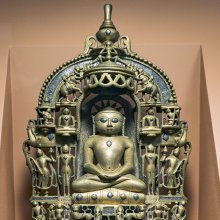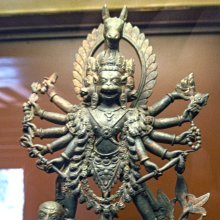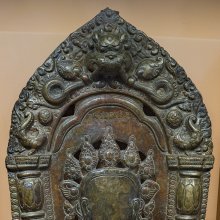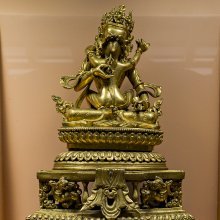Ca: 17 definitions
Introduction:
Ca means something in Hinduism, Sanskrit, the history of ancient India, Marathi, Hindi, Tamil. If you want to know the exact meaning, history, etymology or English translation of this term then check out the descriptions on this page. Add your comment or reference to a book if you want to contribute to this summary article.
Alternative spellings of this word include Cha.
Images (photo gallery)
(+394 more images available)
In Hinduism
Vyakarana (Sanskrit grammar)
Source: Wikisource: A dictionary of Sanskrit grammarCa (च).—(l) the letter च् (c), the vowel अ (a) being added for facility of utterance, cf T. Pr. I. 21; (2) a Bratyahara or short term standing for the palatal class of consonants च्, छ्, ज्,झ् (c, ch, j, jh) and ञ् (ñ); cf इचशेयास्तालौ (icaśeyāstālau) V. Pr. I. 66; (3) indeclinable च (ca) called Nipata by Panini; cf. चादयो (cādayo)Sसत्त्वे (sattve) P. I. 4.57, च (ca) possesses four senses समुच्चय, अन्वाचय, इतरेतरयोग (samuccaya, anvācaya, itaretarayoga) and समाहार (samāhāra) cf. Kas. on II. 2.29. See also M. Bh. on II. 2.29 Vart. 15 for a detailed explanation of the four senses. The indeclinable च (ca) is sometimes used in the sense of 'a determined mention' or avadharana; cf. Kas. on II. 1.48 and 72. It is also used for the purpose of अनुवृत्ति (anuvṛtti) or अनुकर्षण (anukarṣaṇa) i. e. drawing a word from the previous rule to the next rule; (cf. M. Bh. on P. VI. 1.90) with a convention that a word drawn thus, does not proceed to the next rule; cf. चानुकृष्टं नोत्तरत्र (cānukṛṣṭaṃ nottaratra) Par. Sek Pari. 78; (4) a conventional term for अभ्यास (abhyāsa) (reduplicative syllable) used in the Jainendra Vyakarana; cf. चविकारेषु अपवादा उत्सर्गान्न बाधन्ते (cavikāreṣu apavādā utsargānna bādhante) Kat. Pari. 75.

Vyakarana (व्याकरण, vyākaraṇa) refers to Sanskrit grammar and represents one of the six additional sciences (vedanga) to be studied along with the Vedas. Vyakarana concerns itself with the rules of Sanskrit grammar and linguistic analysis in order to establish the correct context of words and sentences.
Ganitashastra (Mathematics and Algebra)
Source: archive.org: Hindu MathematicsCa (च) refers to the “fourth” (unknown) as it represents an abbreviation of caturtha, according to the principles of Bījagaṇita (“algebra” or ‘science of calculation’), according to Gaṇita-śāstra, ancient Indian mathematics and astronomy.—Lack of an efficient symbolism is bound to give rise to a certain amount of ambiguity in the representation of an algebraic equation especially when it contains more than one known. [...] To avoid such ambiguity, in one instance which contains as many as five unknowns, the abbreviations of ordinal numbers, such as pra (from prathama, first), dvi (from dvitīya, second), tṛ (from tṛtīya, third), ca (from caturtha, fourth) and paṃ (from pañcama, fifth), have been used to represent the unknowns.

Ganitashastra (शिल्पशास्त्र, gaṇitaśāstra) refers to the ancient Indian science of mathematics, algebra, number theory, arithmetic, etc. Closely allied with astronomy, both were commonly taught and studied in universities, even since the 1st millennium BCE. Ganita-shastra also includes ritualistic math-books such as the Shulba-sutras.
India history and geography
Source: Cologne Digital Sanskrit Dictionaries: Indian Epigraphical GlossaryCā.—d8ā (LP), a camp; an attacking party. Note: cā is defined in the “Indian epigraphical glossary” as it can be found on ancient inscriptions commonly written in Sanskrit, Prakrit or Dravidian languages.

The history of India traces the identification of countries, villages, towns and other regions of India, as well as mythology, zoology, royal dynasties, rulers, tribes, local festivities and traditions and regional languages. Ancient India enjoyed religious freedom and encourages the path of Dharma, a concept common to Buddhism, Hinduism, and Jainism.
Languages of India and abroad
Marathi-English dictionary
Source: DDSA: The Molesworth Marathi and English Dictionaryca (च).—&c. are pronounced as ts. Such cases will, for the most part, be noted.
--- OR ---
ca (च).—ind An affix of emphasis or of enhancing power; expressing positiveness, peremptoriness, particularity, exactness, certainty &c. It corresponds with our Very, self, indeed, surely &c. Ex. tō cōraca āhē He is verily a thief. tōca cōra āhē He is a thief. tumhīca yā Come yourself; tumhī yāca Come at all risks, you must come. mī jēvatāñca uṭhalōṃ I rose instantly after my meal. mī yēīnaca or mī yēīnaca yēīna I will come, assuredly, positively. It seems further to have a qualifying significancy. Ex. tō paṇḍita barāca āhē That Panḍit is passable, he will serve. Ex. paḍhalēlā grantha bahuta divasa na pāhilā asatāṃ pārakā pārakāca disūṃ lāgatō.
--- OR ---
cā (चा).—The declinable postposition marking the sixth or genitive case. It notes I. Property or possession; as hēṃ tyācēṃ ghara. II. Appropriation, adaptation, particular application; as hā basāvayācā dhōṇḍā; tī snānācī dhōṇḍa. III. Time, or the coexistence of a time with an event,--at, on &c.; as mī dupāracā yēīna; tō sāñjacā gēlā; tō kēvhāñcā yē- ūna basalā. IV. Connection, relation, appertainment, throughout the variations of sense of these words; as gāṃvacā pāṭīla; mulācā bāpa; jhāḍācēṃ pāna; nityadānācā brāhmaṇa; gharacā paikā. V. Completeness, allness or wholeness, utterness; thus corresponding with Hindustani; as paikyācā paikā; gharacēṃ ghara; mahinyācā mahinā All the money or the money utterly; the whole house; the whole month from beginning to end. N.B. Here the governing noun is always reduplicated. Pr. bāpācā bāpa gēlā bōmbalatāṃ hāta gēlā. VI. Change from and unto. Ex. daridryācā śrīmanta hōtō śrīmantā- cā daridrī hōtō. cā sometimes inflects, sometimes does not inflect, the noun assuming it. The difference of signification in these cases it will be advantageous to note. Inflecting the noun, it expresses any accidental connection or relation; as gharacā dhanī Owner of the house; gharacā paikā Money resulting from (the sale, rent &c. of) the house: not inflecting the noun, it expresses a closer and more intimate connection--an inherence, appertainment, dependence &c.; as gharacā dhanī Master of the family; gharacā paikā Family-stock or capital; gharacīṃ māṇasēṃ Inmates of the house, the household; aṅgacēṃ baḷa Bodily strength. Inflecting the noun, cā is in government, and is the postposition marking the genitive case: not inflecting the noun, cā simply serves to form the assuming noun into an adjective.
Source: DDSA: The Aryabhusan school dictionary, Marathi-Englishca (च).—The sixth consonant.
--- OR ---
ca (च).—ind An affix of emphasis or of en- hancing power; expressing positive- ness, peremptoriness, particularity, exactness, certainty &c. It corres- ponds with Very, self, indeed, surely &c.
Marathi is an Indo-European language having over 70 million native speakers people in (predominantly) Maharashtra India. Marathi, like many other Indo-Aryan languages, evolved from early forms of Prakrit, which itself is a subset of Sanskrit, one of the most ancient languages of the world.
Sanskrit dictionary
Source: DDSA: The practical Sanskrit-English dictionaryCa (च).—a.
1) Seedless.
2) Bad, vile.
-caḥ An epithet of Śiva.
2) Chewing, eating.
3) The moon.
4) A tortoise.
5) A thief. चश्चञ्चुश्चरणोऽर्चिर्मुखो रविः । चा कद्रूरदितिः कन्या (caścañcuścaraṇo'rcirmukho raviḥ | cā kadrūraditiḥ kanyā) ...... and चं चरित्रं सुखं दुःखं कश्मलं भ्रमणं पयः (caṃ caritraṃ sukhaṃ duḥkhaṃ kaśmalaṃ bhramaṇaṃ payaḥ) | Enm. -ind. A particle expressing
1) Copulation (and, also as well as, moreover) used to join words or assertions together; (in this sense it is used with each of the words or assertions which it joins together; or it is used after the last of the words or assertions so joined but it never stands first in a sentence); मनो निष्ठाशून्यं भ्रमति च किमप्यालिखति च (mano niṣṭhāśūnyaṃ bhramati ca kimapyālikhati ca) Mālatīmādhava (Bombay) 1.31; तौ गुरुर्गुरुपत्नी च प्रीत्या प्रतिननन्दतुः (tau gururgurupatnī ca prītyā pratinanandatuḥ) R.1.57; Manusmṛti 1.64;3.5; कुलेन कान्त्या वयसा नवेन गुणैश्च तैस्तैर्विनयप्रधानैः (kulena kāntyā vayasā navena guṇaiśca taistairvinayapradhānaiḥ) R.6.79; Manusmṛti 1.15;3.116.
2) Disjunction (but, still, yet); शान्तमिदमाश्रमपदं स्फुरति च बाहुः (śāntamidamāśramapadaṃ sphurati ca bāhuḥ) Ś.1.14.
3) Certainly, determination, (indeed certainly, exactly, quite, having the force of eva); अतीतः पन्थानं तव च महिमा वाङ्मनसयोः (atītaḥ panthānaṃ tava ca mahimā vāṅmanasayoḥ) G. M.; ते तु यावन्त एवाजौ तावांश्च ददृशे स तैः (te tu yāvanta evājau tāvāṃśca dadṛśe sa taiḥ) R.12.45.
4) Condition (if = cet); जीवितुं चेच्छसे (jīvituṃ cecchase) (= icchase ced) मूढ हेतुं मे गदतः शृणु (mūḍha hetuṃ me gadataḥ śṛṇu) Mb; लोभ- श्चास्ति (lobha- ścāsti) (asti ced) गुणेन किम् (guṇena kim) Bhartṛhari 2.45 v. l.
5) It is often used expletively (pādapūraṇārthe); भीमः पार्थस्तथैव च (bhīmaḥ pārthastathaiva ca) G. M. (Lexicographers give, besides the above, the following senses of [ca] which are included in the general idea of copulation; 1 anvācaya joining a subordinate fact with a principal one; bho bhikṣāmaṭa gāṃ cānaya; see anvācaya.
2) samā- hāra collective combination; as pāṇī ca pādau ca pāṇipādam
3) itaretarayoga or mutual connection; as plakṣaśca nyagrodhaśca plakṣa- nyagrodhau.
4) samuccaya aggregation; as pacati ca paṭhati ca). च (ca) is frequently repeated with two assertions (1) in the sense of 'on the one hand-on the other hand', 'though-yet', to denote antithesis; न सुलभा सफलेन्दुमुखी च सा किमपि चेद- मनङ्गविचेष्टितम् (na sulabhā saphalendumukhī ca sā kimapi ceda- manaṅgaviceṣṭitam) V.2.9;4.3; R.16.7; or (2) to express simultaneous or undelayed occurrence of two events (no sooner than, as soon as); ते च प्रापुरुदन्वन्तं बुबुधे चादि- पूरुषः (te ca prāpurudanvantaṃ bubudhe cādi- pūruṣaḥ) R.1.6;3.4;11.5,81; Kumārasambhava 3.58,66; Ś 6.7; Mālatīmādhava (Bombay) 9.39.
--- OR ---
Ca (च).—1 P. (camati, cānta)
1) To drink, sip, drink off; चचाम मधु माध्वीकं (cacāma madhu mādhvīkaṃ) Bhaṭṭikāvya 14.94.
2) To eat. ... मांसं चेमुर्जगुः पपुः (māṃsaṃ cemurjaguḥ papuḥ) | Bhaṭṭikāvya 14.53.
Derivable forms: cam (चम्).
Source: Cologne Digital Sanskrit Dictionaries: Shabda-Sagara Sanskrit-English DictionaryCa (च).—The twentieth letter of the alphabet, and first of the second or palatial class of consonants, having the sound of Ch in church.
--- OR ---
Ca (च).—mfn. (caḥ-cā-caṃ) 1. Seedless. 2. Vile, base. m.
(-caḥ) 1. A name of Shiva. 2. The moon. 3. A theif. 4. A tortoise. Ind A particle and conjunction copulative or disjunctive. corresponding to. 1. And. 2. Also, 3. Moreover. 4. Mutually. 5. Equally. 6. Otherwise. 7. For, on account of. 8. But. &c. 9. An expletive. E. car to go, or ci to collect, &c. ḍa aff.
Source: Cologne Digital Sanskrit Dictionaries: Benfey Sanskrit-English DictionaryCa (च).—I. A copulative particle, And. Where two things are to be joined, it is, 1. Repeated, ca
— ca (like [Latin] que
— que), As well
— As, and, saṃjīvayati cājasraṃ pramāpayati cāvyayaḥ, That immutable power revivifies as well as destroys in eternal succession, [Mānavadharmaśāstra] 1, 57; daśa cāṣṭau ca, Ten and eight, [Mānavadharmaśāstra] 1, 64. 2. Dropped in the first place; this is the general use, [Hitopadeśa] i. [distich] 33. 3. Dropped, but not often, in the second place, e. g. pretya ceha, In the next world and in this, [Mānavadharmaśāstra] 3, 20. Where more than two things are to be joined, some have the conjunction, while others are without it, e. g. karṇau carma ca bālāṃś ca vastiṃ snāyuṃ ca rocanām, (let him carry) their ears, their hides, their tails, the skin below their navels, their tendons, and the liquor exuding from their foreheads, [Mānavadharmaśāstra] 8, 234. Ii. When followed by vā, Either, [Mānavadharmaśāstra] 12, 89; when preceded by vā, Or, [Nala] 14, 8. Iii. Even, [Śākuntala, (ed. Böhtlingk.)] 6, 5; and even, [Hiḍimbavadha] i. 26. Iv. Just, [Raghuvaṃśa, (ed. Stenzler.)] 12, 45. V. But, [Hitopadeśa] [prologue.] [distich] 12. Vi. If, [Bhartṛhari, (ed. Bohlen.)] 2, 45.
— Cf. [Latin] que; [Gothic.] -h, e. g. in sa-h, ‘and he.’
Source: Cologne Digital Sanskrit Dictionaries: Cappeller Sanskrit-English DictionaryCa (च).—([enclitic]) and, also; even, just; but, yet; if. It is often joined with api & eva.
— ca—ca as well—as, both-and (also ca—tu), no sooner-than, although — yet; [with] neg. neither—nor. ca—na ca (tu) although — yet not, na ca—ca although not—nevertheless.
Source: Cologne Digital Sanskrit Dictionaries: Monier-Williams Sanskrit-English Dictionary1) Ca (च):—1. ca the 20th letter of the alphabet, 1st of the 2nd (or palatal) class of consonants, having the sound of ch in church.
2) 2. ca ind. and, both, also, moreover, as well as (= τε, [Latin] que, placed like these particles as an enclitic after the word which it connects with what precedes; when used with a personal pronoun this must appear in its fuller accented form (e.g. tava ca mama ca [not te ca me ca], ‘both of thee and me’), when used after verbs the first of them is accented, [Pāṇini 8-1, 58 f.]; it connects whole sentences as well as parts of sentences; in [Ṛg-veda] the double ca occurs more frequently than the single (e.g. ahaṃ ca tvaṃ ca, ‘I and thou’, [viii, 62, 11]); the double ca may also be used somewhat redundantly in class. Sanskṛt (e.g. kva hariṇakānāṃ jīvitaṃ cātilolaṃ kva ca vajra-sārāḥ śarās te, ‘where is the frail existence, of fawns and where are thy adamantine arrows?’ [Śakuntalā i, 10]); in later literature, however, the first ca is more usually omitted (e.g. ahaṃ tvaṃ ca), and when more than two things are enumerated only one ca is often found (e.g. tejasā yaśasā lakṣmyā sthityā ca parayā, ‘in glory, in fame, in beauty, and in high position’ [Nalopākhyāna xii, 6]); elsewhere, when more than two things are enumerated, ca is placed after some and omitted after others (e.g. ṛṇa-dātā ca vaidyaś ca śrotriyo nadī, ‘the payer of a debt and a physician [and] a Brāhman [and] a river’ [Hitopadeśa i, 4, 55]); in [Vedic or Veda] and even in class. Sanskṛt [Manu-smṛti iii, 20; ix, 322; Hitopadeśa], when the double ca would generally be used, the second may occasionally be omitted (e.g. indraś ca soma, ‘both Indra [and thou] Soma’ [Ṛg-veda vii, 104, 25]; durbhedyaś cāśusaṃdheyaḥ, ‘both difficult to be divided [and] quickly united’ [Hitopadeśa i]); with lexicographers ca may imply a reference to certain other words which are not expressed (e.g. kamaṇḍalau ca karakaḥ, ‘the word karaka has the meaning ‘pitcher’ and other meanings’); sometimes ca is = eva, even, indeed, certainly, just (e.g. su-cintitaṃ cauṣadhaṃ na nāma-mātreṇa karoty arogam, ‘even a well-devised remedy does not cure a disease by its mere name’ [Hitopadeśa]; yāvanta eva te tāvāṃśca saḥ, ‘as great as they [were] just so great was he’ [Raghuvaṃśa xii, 45]); occasionally ca is disjunctive, ‘but’, ‘on the contrary’, ‘on the other hand’, ‘yet’, ‘nevertheless’ (varam ādyau na cāntimaḥ, ‘better the two first but not the last’ [Hitopadeśa] ; śāntam idam āśrama-padaṃ sphurati ca bāhuḥ, ‘this hermitage is tranquil yet my arm throbs’ [Śakuntalā i, 15]); ca-ca, though-yet, [Vikramorvaśī ii, 9]; ca-na ca, though yet not, [Patañjali]; ca-na tu ([varia lectio] nanu) idem, [Mālavikāgnimitra iv, 8]; na ca-ca, though not yet, [Patañjali]; ca may be used for vā, ‘either’, ‘or’ (e.g. iha cāmutra vā, ‘either here or hereafter’ [Manu-smṛti xii, 89]; strī vā pumān vā yac cānyat sattvam, ‘either a woman or a man or any other being’ [Rāmāyaṇa]), and when a [negative] particle is joined with ca the two may then be translated by ‘neither’, ‘nor’; occasionally one ca or one na is omitted (e.g. na ca paribhoktuṃ naiva śaknomi hātum, ‘I am able neither to enjoy nor to abandon’ [Śakuntalā v, 18]; na pūrvāhṇe na ca parāhṇe, ‘neither in the forenoon nor in the afternoon’); ca-ca may express immediate connection between two acts or their simultaneous occurrence (e.g. mama ca muktaṃ tamasā mano manasijena dhanuṣi śaraś ca niveśitaḥ, ‘no sooner is my mind freed from darkness than a shaft is fixed on his bow by the heart-born god’, [vi, 8]); ca is sometimes = ced, ‘if’ (cf. [Pāṇini 8-1, 30]; the verb is accented), [Ṛg-veda; Atharva-veda; Mahābhārata; Vikramorvaśī ii, 20; Bhartṛhari ii, 45]; ca may be used as an expletive (e.g. anyaiś ca kratubhiś ca, ‘and with other sacrifices’); ca is often joined to an [adverb] like eva, api, tathā, tathaiva, etc., either with or without a [negative] particle (e.g. vairiṇaṃ nopaseveta sahāyaṃ caiva vairiṇaḥ, ‘one ought not to serve either an enemy or the ally of an enemy’ [Manu-smṛti iv, 133]); (See eva, api, etc.) For the meaning of ca after an interrogative See 2. ka, 2. kathā, kim, kva);
3) cf. τε, [Latin] que, pe (in nempe etc.); [Gothic] uh; [Zend] ca; Old [Persian] cā.
4) 3. ca mfn. pure, [cf. Lexicographers, esp. such as amarasiṃha, halāyudha, hemacandra, etc.]
5) moving to and fro, [cf. Lexicographers, esp. such as amarasiṃha, halāyudha, hemacandra, etc.]
6) mischievous, [cf. Lexicographers, esp. such as amarasiṃha, halāyudha, hemacandra, etc.]
7) seedless, [cf. Lexicographers, esp. such as amarasiṃha, halāyudha, hemacandra, etc.]
8) m. a thief, [cf. Lexicographers, esp. such as amarasiṃha, halāyudha, hemacandra, etc.]
9) the moon, [cf. Lexicographers, esp. such as amarasiṃha, halāyudha, hemacandra, etc.]
10) a tortoise, [cf. Lexicographers, esp. such as amarasiṃha, halāyudha, hemacandra, etc.]
11) Śiva, [cf. Lexicographers, esp. such as amarasiṃha, halāyudha, hemacandra, etc.]
Source: Cologne Digital Sanskrit Dictionaries: Yates Sanskrit-English Dictionary1) Ca (च):—ch. The 1st of the 2nd class or palatial class of consonants.
2) (caḥ) 1. m. A name of Shiva; the moon; thief; a tortoise.
[Sanskrit to German]
Sanskrit, also spelled संस्कृतम् (saṃskṛtam), is an ancient language of India commonly seen as the grandmother of the Indo-European language family (even English!). Closely allied with Prakrit and Pali, Sanskrit is more exhaustive in both grammar and terms and has the most extensive collection of literature in the world, greatly surpassing its sister-languages Greek and Latin.
Hindi dictionary
Source: DDSA: A practical Hindi-English dictionaryCa (च) [Also spelled ch]:——the first letter of the second pentad (i.e. [cavarga]) of the Devnagri: alphabet; a click sound produced by the impact of the tongue on the hard palate as an expression of pity, disgust, etc., what a pity! How sad! How bad! etc., also [c ..c...].
...
Kannada-English dictionary
Source: Alar: Kannada-English corpusCa (ಚ):—
1) [noun] (gen. pronounced with the vowel 'ಅ') the twentieth letter of Kannaḍa alphabet and the sixth consonant.
2) [noun] (math.) a symbol for the number six.
--- OR ---
Cā (ಚಾ):—
1) [noun] a sound made in jubilation.
2) [noun] a sound produced while driving cattle, sheep, etc.
--- OR ---
Cā (ಚಾ):—
1) [noun] the white-flowered, evergreen plant Thea sinensis (= Camelia thea, = C. sinensis) of Theaceae family; tea plant.
2) [noun] its dried and processed leaves used to make a beverage; tea leaves.
3) [noun] the beverage made by soaking such leaves in boiling water; tea.
Kannada is a Dravidian language (as opposed to the Indo-European language family) mainly spoken in the southwestern region of India.
Tamil dictionary
Source: DDSA: University of Madras: Tamil LexiconCa (ச) . The compound of ச் [c] and அ. [a.]
--- OR ---
Ca (ச) particle < sa. With, together, used as a prefix in Sanskritic words, as சமூலம்; உடன் என்னும் பொருளதாய் வடசொற்களில் மொழிக்கு முன் னாகவரும் இடைச்சொல். [samulam; udan ennum porulathay vadasorkalil mozhikku mun nagavarum idaichol.]
--- OR ---
Cā (சா) . The compound of ச் [c] and ஆ. [a.]
--- OR ---
Cā (சா) [cātal] 13 intransitive verb cf. śav. [Telugu: caccu, K. sā, M. cā.]
1. To die; இறத்தல். சாதலி னின்னாத தில்லை [irathal. sathali ninnatha thillai] (திருக்குறள் [thirukkural], 230).
2. To be spoiled or blighted, as crops; பயிர் முதலியன கெட்டுப் போதல். பயிர் தண்ணீரில்லாமற் சாகிறது. [payir muthaliyana kettup pothal. payir thannirillamar sagirathu.]
3. To be exhausted; சோர்தல். கைகால் செத்துப் போயின. [sorthal. kaigal sethup poyina.]
--- OR ---
Cā (சா) noun See சாவு. [savu.]
--- OR ---
Cā (சா) noun < jyā. (Astronomy) Chord of an arc; sine of an arc; வட்டக்கோட்டின் ஒரு பகுதியின் இருமுனைகளையும் சேர்க்குங் கோடு. [vattakkottin oru paguthiyin irumunaigalaiyum serkkung kodu.]
--- OR ---
Cā (சா) noun < Urdu chā. Tea-plant; தேயிலைச் செடி. [theyilais sedi.] Local usage
Tamil is an ancient language of India from the Dravidian family spoken by roughly 250 million people mainly in southern India and Sri Lanka.
Nepali dictionary
Source: unoes: Nepali-English DictionaryCa (च):—n. the sixth consonant of the Devanagari syllabary with /tʃ/ sound, and in this dictionary, the phonetic symbol for च [ca ] is /tʃə/ and /cha/;
Nepali is the primary language of the Nepalese people counting almost 20 million native speakers. The country of Nepal is situated in the Himalaya mountain range to the north of India.
See also (Relevant definitions)
Starts with (+9980): Ca chang diang, Ca hoi, Ca las nhor, Ca lich, Ca truc, Ca-kurarparavai, Caa, Caa y xaasu hoor, Caa-ehe, Caa-gamba, Caaginja, Caat attie poo, Caat mallica vayr, Caat-aralie, Caay bas beejnh, Caay bof cajp, Caay bof cajp nuwowsc, Caay boof deef, Caay boong cuwst heo, Caay boong thusi.
Ends with (+2996): Abaruca, Abhedyakavaca, Abhijacca, Abhisamecca, Abhishoca, Abhisica, Abhivihacca, Abhiyanca, Abhrapishaca, Abhyantaratasankoca, Abhyarca, Abhyarcca, Abronia elliptica, Abruca, Aca, Acacia abyssinica, Acacia brevispica, Acacia nilotica, Acalypha indica, Acalypha neptunica.
Full-text (+13809): Cha, Sha, Anica, Kimpaca, Avikaca, Anukrakaca, Nakhampaca, Kuvaca, Kharimpaca, Kritashauca, Durvaca, Mitampaca, Tvaca, Udarapishaca, Uccavaca, Akaca, Krakaca, Vikaca, Vaca, Dronampaca.
Relevant text
One of your search terms exceeds the minimun character amount per search term. This amount currently equals 2.
No search results for Ca, Cā, Cha, Sa, Saa; (plurals include: Chas, Saas) in any book or story.
Related products
(+13 more products available)











